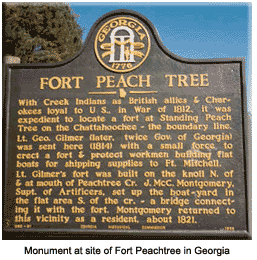Fort Peachtree situated in Atlanta, Georgia, is the replica of the first non-Indian settlement in Atlanta. Built by City of Atlanta Bureau of Water and near the Atlanta Waterworks pumping station, the fort overlooks the Chattahoochee River at its confluence with Peachtree Creek.
The history of Fort Peachtree begins with the War of 1812. The Chattahoochee River was the frontier between the Creek and Cherokee Indian nations and a standing peachtree was a major contact point for both Indians and white traders. During the War of 1812, active aggressions by the Cherokee befell against the Creek Indians who were allied with the British. In the summer of 1813, Georgia Governor David Mitchell, after correspondence with the Secretary of War, acted to protect the frontier of Georgia from the Creeks.
 Fort Peachtree was constructed by James Montgomery, under the supervision of Lieutenant Gilmer. The Creeks ceded the land to the Cherokees under their treaty with General Andrew Jackson, and it became a part of Georgia reserved to Jasper County. On July 14, 1814, Fort Peachtree, the boat yard, five boats, two large block houses, six dwellings, and one storehouse had been constructed. It constituted the core of the first non-Indian settlement in Atlanta.
Fort Peachtree is preserved by an organization named Fort Peachtree Chapter, national Society of the Daughters of the American Revolution (DAR). They are dedicated to perpetuate the memory and the spirit of the men and women who achieved American Independence and to foster patriotic citizenship.
Fort Peachtree was constructed by James Montgomery, under the supervision of Lieutenant Gilmer. The Creeks ceded the land to the Cherokees under their treaty with General Andrew Jackson, and it became a part of Georgia reserved to Jasper County. On July 14, 1814, Fort Peachtree, the boat yard, five boats, two large block houses, six dwellings, and one storehouse had been constructed. It constituted the core of the first non-Indian settlement in Atlanta.
Fort Peachtree is preserved by an organization named Fort Peachtree Chapter, national Society of the Daughters of the American Revolution (DAR). They are dedicated to perpetuate the memory and the spirit of the men and women who achieved American Independence and to foster patriotic citizenship.